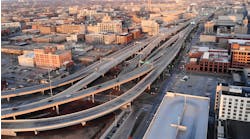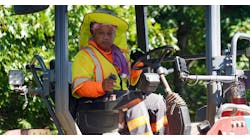Most of the time it’s like watching kindergartners during a fire drill.
As motorists take a left turn off the Blue and Gray Parkway onto Lafayette Boulevard in the thick of Fredericksburg, Va., one moves in front, the other moves in back and with a collective calm a single-file line is quickly formed before a lane merge.
Unfortunately, there are the rare occurrences when people just get caught up in the moment. In May 2006, two cars fought for the prime position. Situated side by side and traveling at a high rate of speed, one of the drivers tried to force its way into the left lane, causing the other to swerve into oncoming traffic. The result was fatal.
“Fredericksburg is still a small community and a multiple fatality car accident is still a relative rarity, especially in the city,” Doug Fawcett, director of public works for the city of Fredericksburg, told Roads & Bridges. “The community was very upset by it. It was horrific because it was a woman, her adult daughter, the daughter’s 2-year-old baby girl and a young woman that was seven months pregnant [who were killed].”
Fawcett and his associates knew the mending had to be instantaneous, and together they set out to offer a stronger dose of traffic safety counseling to the thousands of drivers passing the intersection daily.
“The accident reconstruction team established they both were traveling at an excessive rate of speed for the design of the roadway or the posted speed limit, which was 35,” said Fawcett. “We concluded that the roadway design is not ideal, but it also is not what we would define as a dangerous design or a design where the probability of this type of accident happening are high.”
Through the use of additional pavement markings and signage, what was left of that probability took a serious hit—and at little cost.
Tricky, but traditional
Lafayette Boulevard is a major north-south (Rte. 1 Business) carrier that holds more than 20,000 vehicles a day in the city of Fredericksburg. In 1997, the Virginia Department of Transportation completed an east-west connector called the Blue and Gray Parkway. The new setup involved a two-lane left turn area from the Blue and Gray onto Lafayette Boulevard. Once motorists complete the maneuver, they have about 300 yd before the right lane ends and traffic charges up a steep hill. It can be a tricky maneuver, but most know what is coming. “You go over there and watch it, and our estimate is that about 90% of people that use that portion of the roadway are local drivers that use it repeatedly,” said Fawcett. “If you go over there and watch, you can sit through several cycles of the signal and people come around there side by side and one moves forward and the other drops back. People know that they have to merge. The vast majority of it works just fine, it’s just the exception that you have the very sad consequences.” Officials, however, were no longer accepting the exception and formed a team, which included Fawcett, the city manager, the police department and Kimley-Horn and Associates Inc., a traffic consulting engineering firm located in Chesapeake, Va., to assess the current situation. “We brought [Kimley-Horn] in and worked through a process that resulted in us going out there and making a number of changes that included additional signage and some pavement marking changes,” said Fawcett. More merge signs were installed on southbound Lafayette Boulevard. A total of three—one at 300 ft, one at 200 ft and one at 100 ft prior to the end of the right lane—now warn motorists of the change. A new “No U-Turn” sign also was planted as an extra measure of protection. “We stumbled onto [the “No U-Turn” sign] as we were looking at it,” claimed Fawcett. “It didn’t contribute at all to the accident, but as we were looking at it somebody said there was a problem with the southbound traffic U-turning to go back north at this particular location.”
Perhaps the strongest statement was made with the pavement markings. At the area of the accident there was a center left-turn lane for northbound traffic to turn into an industrial park. The area contained a lengthy taper, and it was determined that it did not need to be as long as it was. Officials took a portion of the left-turn lane and created a gore area, which is a cross-hatched area identified by pavement markings as not being a lane in either direction.
“The purpose of that was to create an area in the vicinity of where people are trying to merge. If somebody does get crowded and there is someone already in the through-lanes and needs to get out of the way, it creates this area where there shouldn’t be any traffic,” explained Fawcett. “It creates a safe zone.” Mini skip marks leading up to the gore area also were installed, as well as a stop bar directing traffic coming off a side street.
“That intersection complicates matters because you have traffic trying to turn into that area both from the south and northbound lanes, and then you have traffic coming out of that street,” said Fawcett. “It’s not a complete intersection, but it is a three-legged intersection.”
All the markings and signage was installed on a day after the morning rush and before the evening rush. Contractor R.J. Merkel handled the work, which was performed for about $5,000.
“It has appeared to work well for us,” said Fawcett. “It has addressed a situation. The one thing we did I thought would make the greatest impact in and of itself was this area where we took part of the turn lane and turned it into a gore area.”
The best solution also was the only logical one. Due to limited right-of-way, officials did not have the luxury of extending the right lane beyond the hill. Fawcett said the city hopes to purchase some additional land around the area in the future, but the right lane will still have to come to an end.
“We are always looking for the opportunity to improve signage or pavement markings to improve the roadway, whether our interests are triggered by an accident or simply our own observations. Like any city, there are always a couple of intersections you are looking at or a couple of stretches of roadway where you don’t have the option of going in and spending a couple of million dollars to add pavement or install intersection rebuilds.
“Everything we have done here we believe is consistent with good engineering practice.”


